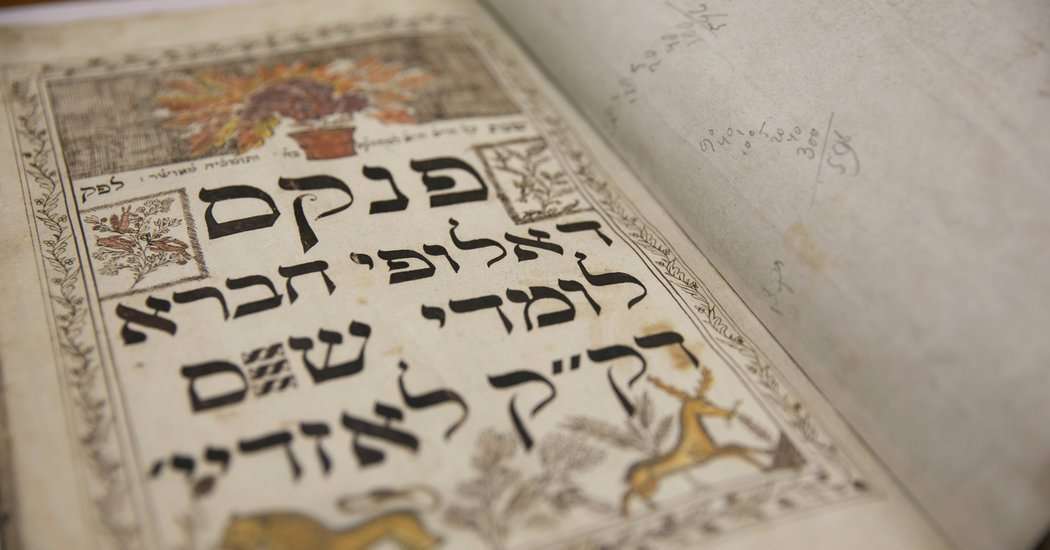Almost as intriguing as the cache is the serpentine story of the documents’ rescue and rediscovery, much of which had been known before but which has been updated with the new find.
When the Nazis occupied Lithuania from 1941 to 1944, they were determined to incinerate or grind up the country’s Jewish collections, particularly those at YIVO, which from 1925 to 1940 in Vilna was the world’s foremost library of Jewish life in Eastern Europe. With characteristic incongruity, though, they decided to save a third of the YIVO collection for a research center near Frankfurt that would study “the Jewish question” even if they planned to make sure the Jews would be extinct. (In Lithuania alone, 90 percent of the prewar Jewish population of 160,000 was murdered.)
Advertisement Continue reading the main story
They needed Yiddish speakers to analyze and select the materials, and deployed 40 ghetto residents like Sutzkever and another raffish poet, Shmerke Kaczerginski, as slave laborers. Risking death by a firing squad, this “paper brigade” rescued thousands of books and documents.
When the Germans were pushed out of Lithuania by the Soviets, survivors like Sutzkever spirited some hidden treasures to New York. (The Soviets frowned on anything evocative of ethnic or religious loyalties.) Meanwhile, a gentile librarian, Antanas Ulpis, who was assembling the remnants of the national library in a former church, St. George’s, stashed stacks of Jewish materials in basement rooms to hide them from Stalin’s enforcers. He is, as a result, regarded by YIVO as a kind of Oskar Schindler of document rescue.
The bulk of the basement collection — documents totaling 250,000 pages — was recovered after the collapse of the Soviet Union in 1991.
Last year, the entire basement collection was transferred to the Martynas Mazvydas National Library of Lithuania, which had reopened in a grand colonnaded building, and in May officials there informed Mr. Brent, of the new trove of 170,000 documents. They had been stored in a separate church basement room and had never been evaluated because none of the assigned archivists could read Yiddish or Hebrew.
Lithuania has chosen to hold onto all the Jewish documents in the library’s Judaica center as part of its national heritage. But it has allowed YIVO to digitize them for the use of the general public — and to have select items to display in Manhattan later this month.
“It’s going to take decades for scholars to analyze all of this,” said Mr. Fishman, who this month published “The Book Smugglers: Partisans, Poets and the Race to Save Jewish Treasures From the Nazis.”
Among the more mundane curiosities that were salvaged is a weathered agreement from 1857 between a yeshiva in Vilna and a union of water carriers.
What is a water carrier, a Talmud student might ask?
In Vilna at that time, water carriers were needed to deliver buckets of water to homes from available wells. The ragtag Jewish water carriers formed a guild, which promised to donate a Torah scroll and a set of Talmuds to the yeshiva if members were given a room of their own, rent-free, for worship.
The crew that rescued these records largely did not survive the war. Some 34 of the 40 people viewed by experts as having been members of the “paper brigade” died, according to Mr. Fishman, some in death camps like Treblinka or in labor camps or in more random fashion. Mr. Kaczerginski was killed in 1954 in a plane crash in the Andes. Sutzkever had an illustrious career as a poet in Israel and died at age 96 in 2010. Mr. Ulpis, who helped save the documents later found in the church basement, died in 1981.

rabbitsnake on October 19th, 2017 at 14:55 UTC »
The novel, Mendelssohn is on the Roof by Jiri Weil, has a sub plot about Yiddish scholars in Czechoslovakia tasked by the Nazis to catalog relics to build a museum.
Garet-Jax on October 19th, 2017 at 14:04 UTC »
It is worth noting that under UNESCO rules the artefacts are the property of the Lithuanian government and not of the Jewish people (or the Jewish Lithuanians).
Today there ~2,000 Jews in Lithuania.
Source
Weywoht on October 19th, 2017 at 12:31 UTC »
I love how people risked everything to save the documents that mattered to them, and love what those documents were. It says something that they saved the autobiography of a fifth grader, for instance, or a copy of Sherlock Holmes. There's something incredibly human about what people wanted to save and does so much to humanise the victims of the Holocaust.